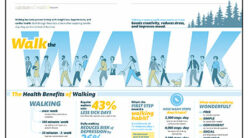Picture this scenario: It’s lunchtime, and you’re taking a brisk walk with a coworker. You know the exercise will help you think more clearly and concentrate better when you get back to work.
Or how about this one: You’ve just finished an exhilarating workout at the gym and you feel pumped. Your skin glistens with perspiration as you head for the shower.
Nice scenarios, both of them, except that you don’t have time (nor maybe the place either) to walk at lunch, and you don’t belong to a gym.
Still, you know exercise is essential to good health, and the knowledge nags at you. But what can you do? Between work and family plus trying to get adequate sleep, and maybe squeeze in a social life, you don’t know how you can possibly fit exercise in, too.
But you can fit it in-seamlessly, in fact-and it’s easy. By following a few simple suggestions, you can reap both the physical and mental benefits of regular exercise, keep the rest of your life on track, and ditch the guilt.
Just 30 minutes a day make a huge difference. And instead of trying to find a 30-minute chunk of time-you already know it isn’t there-divide it into smaller pieces. Ten minutes at a time works just fine. “Actually, it’s even better, depending on what your goal is,” says Connie Tyne, L.M.S.W., at the Cooper Institute of Aerobics Research in Dallas, Texas. One common misconception about exercise, she says, “is the volume theory-that a large volume of exercise is required for improvement in health and well being. . . .The truth is this only applies if you’re seeking a very high level of fitness or you’re going to be a competitive athlete. . . .
“Our research has shown that among women 45 and older who don’t exercise vigorously, those who start walking the equivalent of an hour a week-which is breaking it down into very small pieces-can lower their risk of coronary artery disease by half. And that was a study with 40,000 female health professionals.”
Besides lowering our risk of coronary artery disease, daily exercise also reduces the risk of developing Type II diabetes, helps control weight, increases muscle strength, helps us maintain our independence as we age, and much more.
“Movement is life,” says Art Brownstein, M.D., M.P.H., in his book Healing Back Pain Naturally (Harbor Press, 1999), “and when we stop moving certain parts of our body, muscles stiffen and weaken, joints freeze up, and pain increases when we apply a force of any kind to these areas.”
But the benefits of regular exercise are a case of one good thing leading to another.
“Regular exercise has been shown to lead to weight loss,” he says. “Weight loss decreases the stresses and strains on the spine, improves appearance and self-esteem, lifts spirits, and provides added energy to the body. With weight loss usually comes loss of abdominal belly fat which helps to improve posture and eases the pressure on the lower spine. It can also alleviate depression.”
Getting rid of belly fat is particularly important, says Tyne. “It’s not the fat in our thighs and hips, it’s that stomach fat-the apple-shaped body-that leads to what’s called metabolic syndrome, which puts people at higher risk of heart disease, diabetes, high blood pressure, all the conditions that we know are the killers.” The danger zone, she adds, is a woman’s waist measurement exceeding 35″ and a man’s exceeding 40″.
It’s encouraging to know that we don’t have to exercise in the way we may normally picture exercising-working out on special equipment, jogging, or playing a sport-to reap the benefits. These are fine, but we can, instead, weave exercise into everyday activities so that we cease to think of it as exercise at all.
Many common activities count as aerobic exercise. Among them are: sweeping or mopping the floor, vacuuming, polishing furniture, carrying and putting away groceries, cleaning out closets, washing woodwork, raking leaves, pulling weeds, playing with our children, and walking the dog. If we take this message to heart, we could end up with the cleanest house, best-looking yard, and the happiest children and pets of anyone we know!
Here’s more good news about breaking exercise down into 10-minute increments. “A recent journal article in Medicine and Science concluded three short bouts of brisk walking-so 10 minutes here, 10 minutes there-accumulated throughout the day were at least as effective as one continuous bout as far as reducing cardiovascular risks,” says Tyne. “People actually lost more weight by breaking their exercise into three 10-minute segments.”
To illustrate how this works, she likens it to baking a pizza. First, you heat the oven, then you bake the pizza, then you turn the oven off and it cools down. “When you do the shorter bouts of exercise, you’re heating up your body. . . . You’re burning more calories on the way up to exercise, while you’re exercising, and then there’s a carry-over effect that can last anywhere from 30 minutes to two hours.”
Further, she says, several years ago researchers at the Cooper Institute of Aerobics Research did a study called Project Active. The results were published in the Journal of the American Medical Association in 1999. The study compared structured exercise intervention with lifestyle activity. (In the structured group, participants came to the center and did supervised exercise for about six months. Then the study followed them for the next two years while they were on their own.)
The lifestyle group, however, was never brought into the gym. “They met and had sessions where they just discussed how to get more exercise into their everyday life. Instead of having a lawn service, suppose you do your own lawn-basically, working a lot of activities back into their lives that they had conveniently hired someone else to do-sweeping and vacuuming, cleaning the pool, walking to lunch, delivering memos instead of e-mailing everything, simple things like that. At the end of the first six-month period, the people who were in the structured activity group had lost a little more weight, and were showing more signs of cardiorespiratory fitness. But at the end of two years, they were equal.”
Both groups, she says, “had significant and comparable improvements in their physical activity levels and in their cardiovascular-respiratory fitness over a 24-month period. . . .
“Part of the reason is that people go on and off workout programs. The whole perception that you have to go somewhere to exercise means that you will possibly be less consistent.” But for people who create a new version of normal in their lives “that new version of normal means that when the leaves fall, you sweep them. You just get into the habit of doing more work basically.”
If we use this unstructured group as a model, we learn to take walks and enjoy the changing seasons, to see housework, gardening, and kicking a soccer ball with the kids in a new light-as a prescription for good health.
If you’re unused to exercising, then beginning your program gradually is a good idea. You may want to start with five minutes a day the first week, 10 minutes a day the second, on up to 30 minutes a day the sixth week. This gives your body-and your mind-set- the chance to adjust.
As with any exercise program, even one that begins gently and involves such activities as sweeping away cobwebs or planting flowers, be sure to check with your doctor first. Ask if there are any restrictions on what you should do. And if during exercise you experience any of the following symptoms or similar ones, stop exercising and let your doctor know: nausea, cold sweats, headache, lightheadedness, shortness of breath, or pain in your chest, neck, shoulders, or arms (especially on the left side of your body).
The best way to stick with daily exercise is to develop a routine or list of activities you like and that fit your schedule. That list can certainly include activities that are fun, such as bowling or shooting baskets in the driveway. Most of us are not likely to stick with a program just because it’s good for us. It needs to be pleasant and convenient, too.
To stay motivated, says Tyne, “I think we need a vision of ourselves. You’ve got to look down the road and say, `OK, I’m 40 years old. Where do I want to be at 50? What do I want to be able to do at 60?’ And if you’re on a glide path that’s taking you in the wrong direction, then you make adjustments.
“When I was about twentysomething, I was skiing in Colorado. As I was waiting for my friends at the top of a chairlift, I heard this kid yell, `Come on, Grandma, this way!’ I look up and this kid about 10 years old jumps off a chairlift and this woman gets off after him and they ski off together. My jaw dropped because my grandmothers, precious women that they were, certainly never snow skied. They were the cookie-baking, I’ll-darn-your-socks kind of ladies.
“I didn’t realize it at the time, but my concept of aging was that of my grandparents. You take it easy, people look after you, they come over on Sundays. It wasn’t an active vision at all. But on that beautiful day with the sun shining-and I was having such a great time skiing-I thought, I want to be a skiing grandmother! . . .
“I don’t get up in the morning and exercise to lower my cholesterol,” she says. “It’s just not very exciting. We have to have a vision of who we want to be.”
This kind of vision and a commitment to our own well-being can help us to shape and stick with our own daily exercise routine.







1 thought on “Daily Exercise Matters”
lilly
(June 21, 2010 - 8:07 am)When I started with my yoga routines, it was difficult for me to get up in the mornings, but when I got used to it, it’s like brushing my teeth that I need to do.
Comments are closed.